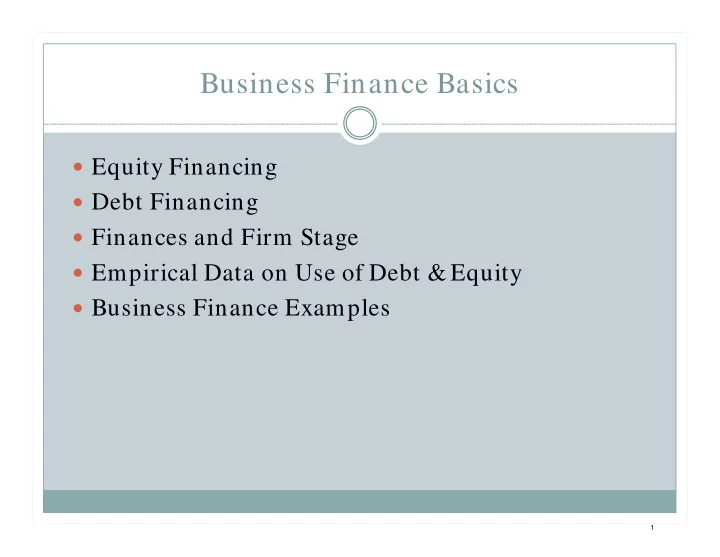

Business Finance Basics Equity Financing Debt Financing Finances and Firm Stage Empirical Data on Use of Debt & Equity Business Finance Examples 1
Equity Financing Definition of equity Governance and financial rights Financial return: dividends and capital gains Forms of equity: preferred stock, common stock, partnership interest, “project equity” Key equity terms Company valuation Voting rights & board representation Registration rights Anti-dilution covenants 2
Key Formulas: Equity Finance Company valuation: Discounted cash flow: Value = Σ CF i / (1+r) i Price/ earnings ratio: Value = PER * stabilized earnings Private investor’s ownership share % of ownership = investment/ (pre-investment company value + investment) Company valuation is inexact Valuation and ownership share is negotiated 3
Debt Financing Definition of debt Financial terms: Principal Interest rate Loan term or maturity Am ortiza tion p eriod Non-financial terms Collateral and security position Guarantees Financial covenants Debt service coverage ratio (cash flow/ P + I) Loan-to-value ratio (loan prin. / appraised value) 4
Selected Types of Debt Trade credit Lines of credits Construction loans Equipment leases Term loans Mini-perm loans Long-term mortgage loans Bonds 5
Annual Returns to Stocks and Bonds, 1928-2014 25.00% 19.90% 20.00% 15.00% S&P 500 Stock 11.53% Index US Treasury Bonds 10.00% 7.80% 5.28% 5.00% 0.00% Average Return Standard Deviation Data s ource: http://www.stern.nyu.edu/~adamodar/pc/datasets/histretSP.xls 6 6
Debt Examples Figure 2-1: Comparison of Principal Balance Over Time, for Interest Only and Amortizing Loans $1 ,000,000.00 $900,000.00 Interest Only $800,000.00 in c ip a l B a la n c e $700,000.00 Partial Amortization $600,000.00 Full $500,000.00 Amortization $400,000.00 L o a n P r $300,000.00 $200,000.00 $1 00,000.00 $0.00 1 2 3 4 5 6 7 8 9 1 0 1 1 1 2 1 3 1 4 1 5 1 6 1 7 1 8 1 9 20 21 22 23 24 25 26 27 28 29 30 31 32 33 34 35 36 Number of Months 7
Average Permanent Loan Terms, 3 rd Quarter 2016 Investor Survey, RealtyRates.com Loan Industrial Office Lodging Restaurant Retail Term s Interest Rate 4.92% 5.18% 5.62% 6.57% 5.06% DSCR 1.49 1.70 1.57 1.66 1.41 LTV .70 .73 .67 .64 .71 Amortization 25 30 22 21 25 (years) Term (years) 11.46 8.0 7.8 7.45 6.20 8
Key Formulas: Debt Financing Principal amount from monthly cash flow pv (monthly interest rate (i), # of months in a m ortiza tion p eriod (n), monthly cash flow for debt service (cf)) Monthly payment for a loan amount Pmt(monthly interest rate, # of months in am ortization period (n), loan principal amount) Outstanding principal balance pv (monthly i, n left in am ortization period , monthly loan payment ) 9
Small Firm Capital Sources Capital Source All Small Small Firms > 20 Sm all Firms < 20 Businesses workers, sales > $1 mm workers, sales < $1 mm Principal Owner Equity 31.33% 44.53% 27.22% Angel Finance 3.59% n.a. n.a. Venture Capital 1.85% n.a. n.a. Other Equity 12.86% n.a. n.a. Total Equity 49.63 56.00% 47.67% Commercial Banks 18.75% 14.88% 19.94% Finance Companies 4.91% 3.08% 5.47% Other Fin. Institution 3.00% 3.53% 2.83% Trade Credit 15.78% 11.81% 17.01% Principal Owner Debt 4.10% 5.59% 3.63% Other Sources 3.83% 5.11% 3.45% Total Debt 50.37% 44.00% 52.33% 10
Firm Stages Seed Stage Start-up Stage 1 to 3 years 1 to 5 years Very small size Small size Pre-growth Slow to moderate growth Limited finance needs More finance needs Few assets Some assets No revenue Unpredictable earnings Maturity Stage Growth Stage 10 + years 5 to 10 years Largest size Medium size Modest growth Rapid growth Renewal investment needs High investment needs Sizeable assets; Sizeable assets may be outdated Some earnings predictability Earnings predictable 11
Capital Sources by Firm Age Capital Source 0-2 Years 3-4 Years 5-25 Years 25+ Years Principal Owner Equity 19.61% 17.37% 31.94% 35.42% Total Equity 47.90% 39.37% 48.00% 56.50% Commercial Banks 15.66% 30.84% 17.86% 17.25% Finance Companies 8.33% 2.51% 5.85% 3.28% Other Fin. Institution 3.84% 2.36% 2.87% 3.38% Trade Credit 13.40% 13.42% 17.10% 13.86% Principal Owner Debt 6.02% 6.19% 3.91% 3.68% Other Sources 4.85% 5.31% 4.41% 2.05% Total Debt 52.10% 60.63% 52.00% 33.50% 12
Empirical Data and Growth Stage Theory High reliance on debt finance (> 50%) at start-up and early stages Heavy use of external institutional debt (40%) at start-up Growth in principle owner equity and total equity after 4 years Owner’s personal assets are important to raising external capital 13
Small Business Credit Use 2009 to 2011 Type of Credit 20 0 9 (%) 20 10 (%) 20 11(%) Line of Credit (all) 45.6% 46.8% 45.4% Line of Credit (<4 yrs) 30.6% 37.5% 26.0% Business Loan (all) 35.9% 31.4% 29.1% Business Loan (<4 yrs) 20.4% 36.2% 14.5% Bus. Credit Card (all) 63.8% 57.5% 58.8% Bus. Credit Card (<4 yrs) No data 49.3% 51.8% Trade Credit (all) No data 57.8% 47.1% Trade Credit (<4 yrs) No data 42.8% 43.8% BOGFRS, Availability of Credit to Small Businesses, April 2012 14
Small Business Credit Sources Courtesy of Karen G. Mills and Brayden McCarthy. 15 Used with permission.
Business Finance Example 1 A neighborhood hardware store is planning to add an equipment rental service to its business. It needs $30,000 to $40,000 to buy the rental equipment and expects rental sales of $3,000 to $3,500 per month. It rents its building with ten years remaining on its lease and has had stable total sales over the past several years. 16
Business Example 2 The owner of a small furniture manufacturer is retiring and is interested in selling the business to her fifteen employees. The firm owns all its building and equipment and has inventory of wood, finished products it values at $50,000, and an existing mortgage loan with a $100,000 balance. The owner is asking $1,000,000 for the business and all its assets. 17
MIT OpenCourseWare https://ocw.mit.edu 1 1.437 Financing Economic Development Fall 201 6 For information about citing these materials or our Terms of Use, visit: https://ocw.mit.edu/terms.
Recommend
More recommend